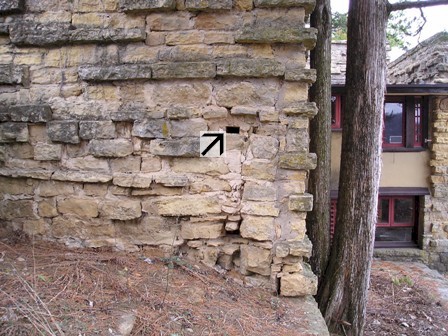The photo at the top of this page shows the living quarters of Taliesin: the portion of the building rebuilt after the fire of 1914 and destroyed in the fire of 1925. Someone took is around 1922.
Frank Lloyd Wright and Taliesin II:1
Frank Lloyd Wright named his home Taliesin, but later wrote that the building after the 1914 fire was Taliesin II, and that the building after the second fire (of 1925) was Taliesin III.
Taliesin II gets lost because Wright built it after the 1914 fire (caused by an act of violence). Then, in 1925, an electrical fire again destroyed it. Wright began rebuilding that summer.
The home that exists today was where Wright lived when:
-
- He recovered his career in architecture
- Started the Taliesin Fellowship
- Designed some of his most well-known buildings (including Fallingwater), and
- Became, apparently, the first “starchitect”
Although, as of 1939 his main studio in Wisconsin was his newly designed and built drafting studio at Hillside2 on the southern part of his Taliesin estate (which I wrote about in an earlier blog post).
So Taliesin II gets overshadowed
Also, Wright was out of the country a lot from 1915-1922 , working in Tokyo on the Imperial Hotel.
Still, by the time he finished with the Imperial Hotel, he had added two more rooms to Taliesin’s living quarters (on the ground floor and one above that). Then made that part of the building taller.
Here’s that part of the building in the early 1920s:
From the Eric Milton Nicholls Collection at the National Library of Australia
The Griffins took the photograph above on their trip to the United States in 1924-25. Compare this photo to the one at the top of the page: the chimney you see here on the right on the photo at the top of the page is the same chimney that you see on the left in the photo above. The photographer took this photo from the Hill Crown at Taliesin. On the right hand side of the photograph was a guest room. Today, that’s part of Frank Lloyd Wright’s bedroom.
The photo comes from the National Library of Australia
Take a look at this page, where you can get more information on the photo. It comes from the collection of Eric Milton Nicholls, architectural partner to husband and wife architects Walter Burley Griffin and Marion Mahony Griffin.
Down on this page, you’ll see that I put hyperlinks to all of the photographs that the Griffins took of Taliesin.
In addition to the changes Wright did at his living quarters, he extended Taliesin to the west, adding a root cellar and ice house in 1916, and, by 1924, another horse stable, and also chicken coops, a granary and a pigsty.3
If Taliesin II had stood longer, more photographs would exist of it.
Plus, the reason for less photographs is that Wright was out of the country for large chunks of time from the late 1910s to the early 1920s. He didn’t return to live full time in the United States until 1922, after he had finished most of his work on Japan’s Imperial Hotel. Then things went sort of “sideways” with his longtime partner, Miriam Noel.
Wright and Noel married in November 1923.
Noel lived with him about 5 or 6 months as his wife. She left by April or early May the next year.
My personal opinion is that those two seemed to bring out the worst in each other. You can read about her in Meryle Secrest’s Wright biography (don’t be afraid of its number of pages—someone told me to skip the first 100). Another book is Frank Lloyd Wright: A Biography, by Finis Farr.
Or you can read the fictionalized Miriam in The Women, by T.C. Boyle.
Wright met Olgivanna Milanoff about six months after Miriam left. Olgivanna, who married him in 1928, moved into Taliesin by January 1925. On April 20 of that year another fire (probably because of bad wiring) struck Taliesin. It destroyed Taliesin’s living quarters. No one died, but Wright lost thousands of dollars worth of Japanese art. While he worked on rebuilding Taliesin, Noel found out about Olgivanna (now pregnant with her and Wright’s child). Miriam’s discovery resulted in more bad press and career problems (even before the stock market crashed in 1929).
That’s the easy version of that story.
Although, when you know where to look, you can find photographs online of Taliesin II.
I’d love to plaster this page with Taliesin II photos, but I think I’d get into trouble (copyrights and all that). So, I will show where you can find these images for the rest of my post.
Photographs of Taliesin II
There are a couple of places where can you find Taliesin II photographs in print:
- An issue from The Journal of the Organic Architecture + Design Archives. This issue shows work one photographer who came to Taliesin three times and took photos (those photos, showing Taliesin I, Taliesin II, and Taliesin III, are some of the best that exist).
- Taliesin: Global Architecture Traveler Series, originally Selected Houses: Volume 2. “Global Architecture Traveler Series” is still in print, but I like “Selected Houses volume 2” more. Each page of “Volume 2” is physically longer.
By the way: if you get the “Global Architecture” book, or “Selected Houses v. 2”, trust me when I tell you that, while the cover of the books has a Wright-designed rug on the floor of the Taliesin living room, that rug was never there while he was alive.
Here are links to images on-line:
Eric Milton Nicholls Collection, National Library of Australia:
Nicholls worked in the office in Australia of architects Walter Burley Griffin and his wife, Marion Mahony Griffin.
The site shows seven photos taken on the Taliesin Estate: five show Taliesin II, one shows the dam and waterfall, and one shows the Hillside structure. Of these seven, the Griffins took some when they visited the U.S. in 1924-25 (like the photo I showed above). But one shows Taliesin II a little earlier: https://nla.gov.au/nla.obj-150233395/view. It looks like it was taken around 1917, before the Griffins went to Australia.
Links to the five other photos:
- Looking west in the forecourt after snow. https://nla.gov.au/nla.obj-150233942/view
- The living quarters are behind you and you’re looking toward the farm wing.
- Then in the courtyard toward the west. The Hill Tower is seen above: https://nla.gov.au/nla.obj-150233494/view
- On the Hill Crown, looking at Taliesin’s Hill Tower: https://nla.gov.au/nla.obj-150233643/view
- I do not know who the woman with the dog is. I looked at photos of Marion Mahony Griffin, but she doesn’t look the same as the woman in this photograph.
- Taliesin’s dam and waterfall: https://nla.gov.au/nla.obj-150234091/view
- Here’s the link to the blog post I did on the dam and waterfall.
- Hillside Home School: https://nla.gov.au/nla.obj-150235145/view
- Looking northeast at the stone structure on the south end of the Taliesin estate, which Wright first designed for his aunts.
If for some reason these URLs don’t work, go to the Library of Australia in the Nicholls Collection: https://nla.gov.au/nla.obj-150140881
Go to Search and the Taliesin photographs are on Pages 821-840.
Here are other photographs, most at the Wisconsin Historical Society:
Exteriors
- This is the Taliesin II complex: https://www.wisconsinhistory.org/Records/Image/IM83342
- It’s a view overall from the south.
- Taliesin II Gardens and Pasture Below Building: https://www.wisconsinhistory.org/Records/Image/IM83019
- One of the ways you know you’re looking at Taliesin II is that its east façade is stone (it’s plaster in Taliesin I).
- Taliesin II Porte Cochere roof: https://www.wisconsinhistory.org/Records/Image/IM83337
- The photographer was standing on what became the roof of Wright’s bedroom.
- Taliesin II forecourt looking west: https://www.wisconsinhistory.org/Records/Image/IM83339
- This is just to the north of the previous photograph, but taken on the ground. Wright’s studio is on the right with the hexagonal clerestory window.
- This is further west in the forecourt: https://www.wisconsinhistory.org/Records/Image/IM38764
- You can tell someone took this photograph before the previous photographs: look under the hayloft roof. It does have mullions (Wright added those to the design later). However, you know you’re looking at Taliesin II because the six-sided window in front of the chimney.
- This is looking at the Living Quarters: https://www.wisconsinhistory.org/Records/Image/IM38768
- The caption says “1927”, but it’s wrong.
- I volunteered at the Wisconsin Historical Society hoping to correct the mistakes on the website, but Covid hit in 2020.
- The caption says “1927”, but it’s wrong.
- Taliesin II Entrance Loggia:https://www.wisconsinhistory.org/Records/Image/IM83010
- The “Entrance Loggia” is to on the left hand side of the photo. We know this is Taliesin II because of the rest of the photos in the collection (they were bought together).
Interiors:
- Taliesin II Dining Room:https://www.wisconsinhistory.org/Records/Image/IM83015
- The design of the ceiling shows this to be Taliesin II, not Taliesin I. A Taliesin tour guide told me this years ago (hi, Bryan).
- Aside from the ceiling another thing that shows this is Taliesin II is the design of the chair in the foreground. This “room” is not surrounded by four walls; so, the living room “starts” when the ceiling drops down.
- Another Taliesin II Dining Room photo (from the Frank Lloyd Wright Foundation website), https://franklloydwright.org/an-autobiography-in-wood-and-stone/1403-0038-dining-s/
- It’s showing the same space as the first one above. Go back and forth between the two to see the differences.
- Frank Lloyd Wright at Taliesin, sitting at a table near the window: https://www.wisconsinhistory.org/Records/Image/IM23788
- He’s sitting in Taliesin’s living room, along the east wall, north of the photos of the dining “room” above. So if you were sitting where he was, and looked to your left you would see the dining area.
- Frank Lloyd Wright at the Taliesin Drafting Studio, 1924: https://www.wisconsinhistory.org/Records/Image/IM27896
- We know where he is because of the fireplace on the left hand side of the photograph. The photographer who took this photograph was probably standing in the space where all the drafting was done (which you see in the next photo).
- One of the things I find silly about this photo is that Wright looks to me like he’s 4 feet tall.
- Drafting Studio. https://www.wisconsinhistory.org/Records/Image/IM66179
- The person closest to the photographer was Nobuko Tsuchiura, she was a draftsperson4 at Taliesin with her husband, Kameki, from the beginning of 1924 to the end of 1925.
- Taliesin II Living Room:https://www.wisconsinhistory.org/Records/Image/IM83334
- The TII living room is noted by the long rectangle at the fireplace.
First published on March 2, 2021
I don’t know who took the photograph of the Taliesin II living quarters that is at the top of this entry. I got a copy of it from someone who convinced someone else not to throw this out.
Notes:
1 Some say the words Taliesin I, Taliesin II, and Taliesin III shouldn’t be used. That using these numbers imply the building was completely destroyed twice with a new one built on top of the ruins. But the Taliesin fires only destroyed 1/3 of the building (but not its drafting studio or farm wings).
While I don’t commonly call the house that stands “Taliesin III”, I use those terms because Wright wrote them in his autobiography. Even if someone says he’s wrong, I’m not going to disagree with his choices because Taliesin was his house, and he was a lot smarter than I am or ever will be.
2 And, in a a moment of a snake-eating-its-own-tail thing, I first wrote the Wikipedia page about Hillside that I linked to. I’m using it here to back up my assertion. I’ll try not to link back to this blog post if I update the Wikipedia page on how much work Wright did at the Hillside drafting studio.
3 He labelled it as a pigsty in a floor plan, but someone told me that Wright used it as a goat pen. Probably because even randy goats can smell better than pigs.
4 I asked people who’ve worked in architecture what term I should use to describe Nobuko Tsuchiura. I didn’t know if “draftsman” was proper, and “draftswoman” seemed odd. Someone suggested “draftshuman”, but I thought I should go with something that is more commonly used nowadays. “Draftsperson” was the most suggested so that’s why I put that here.

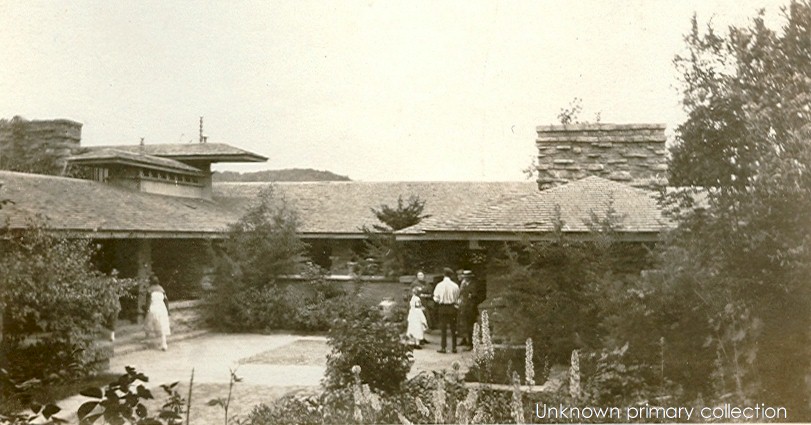
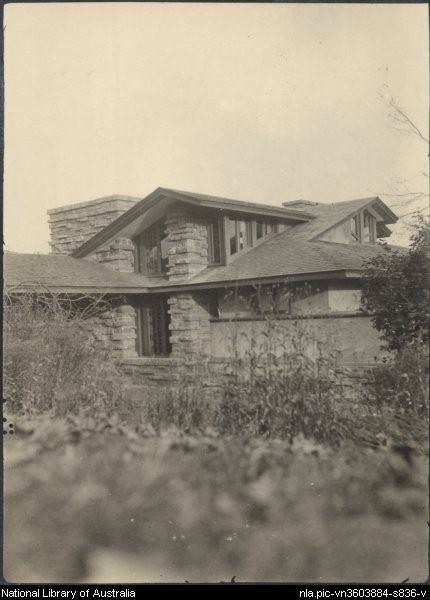
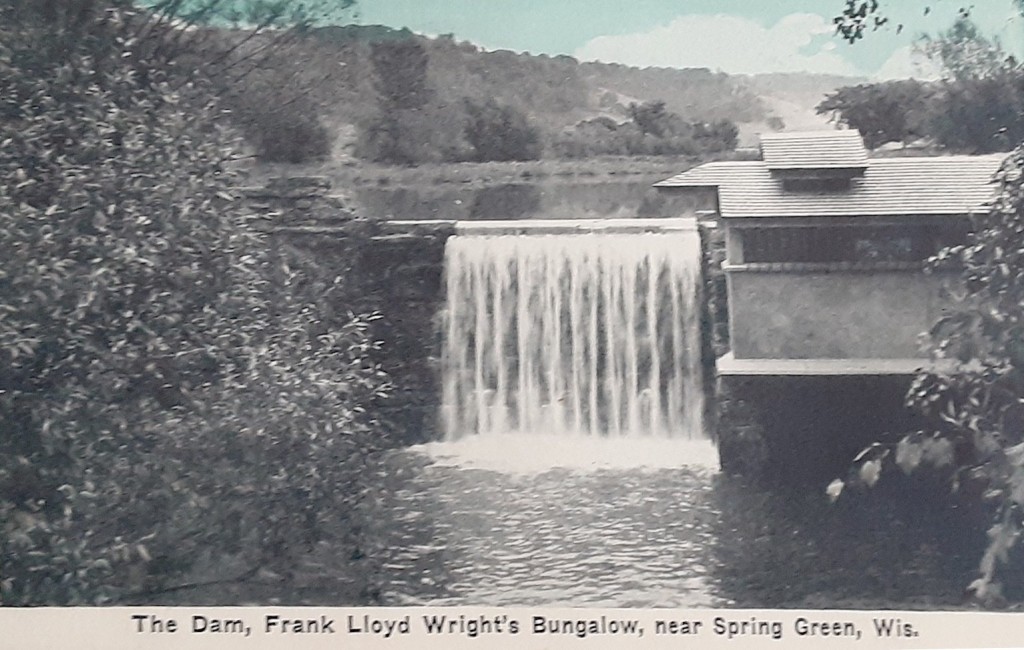

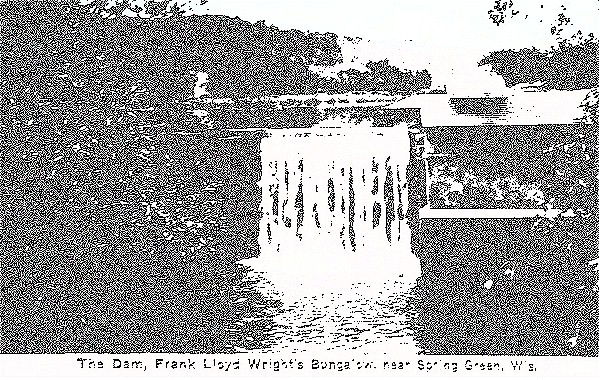
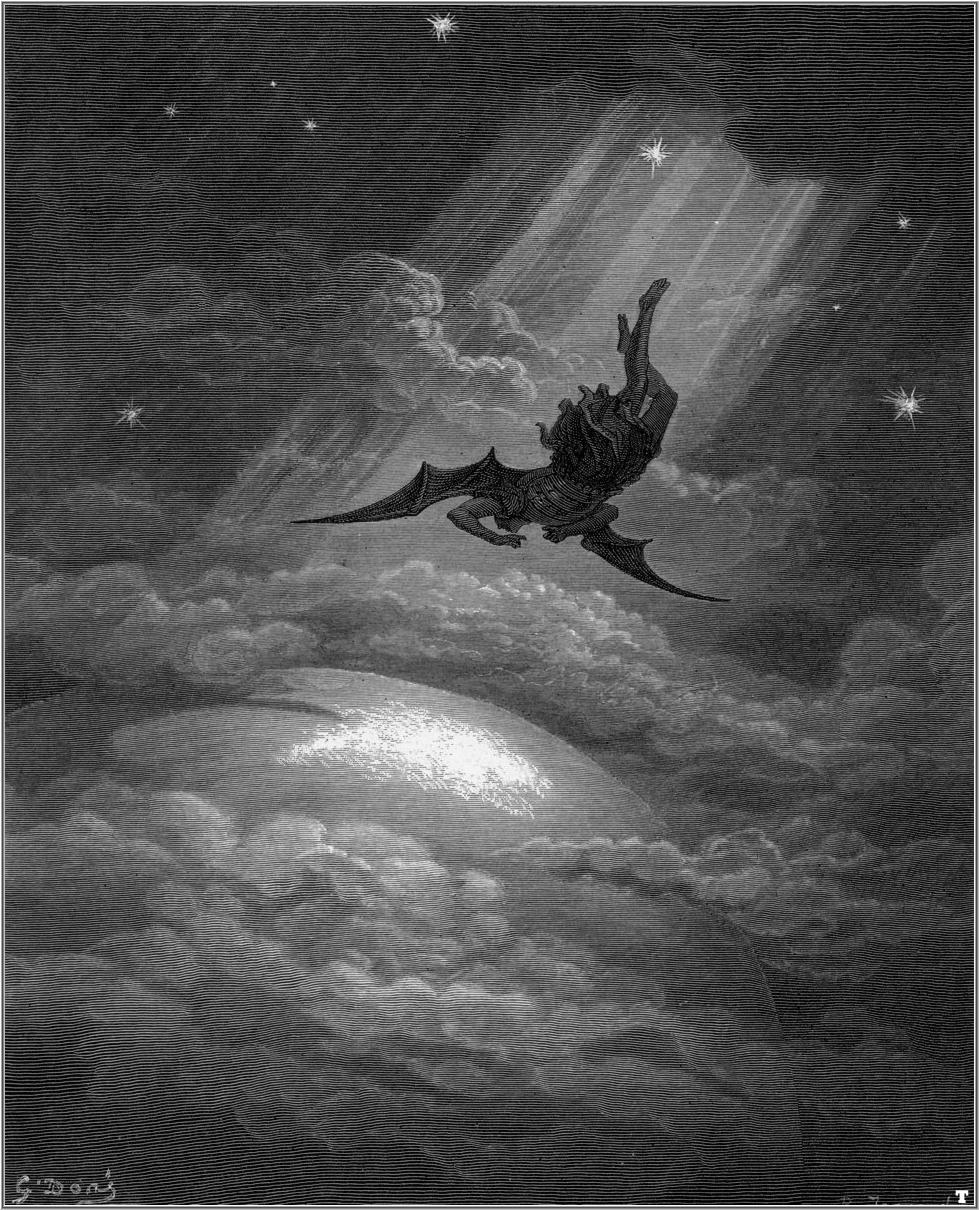
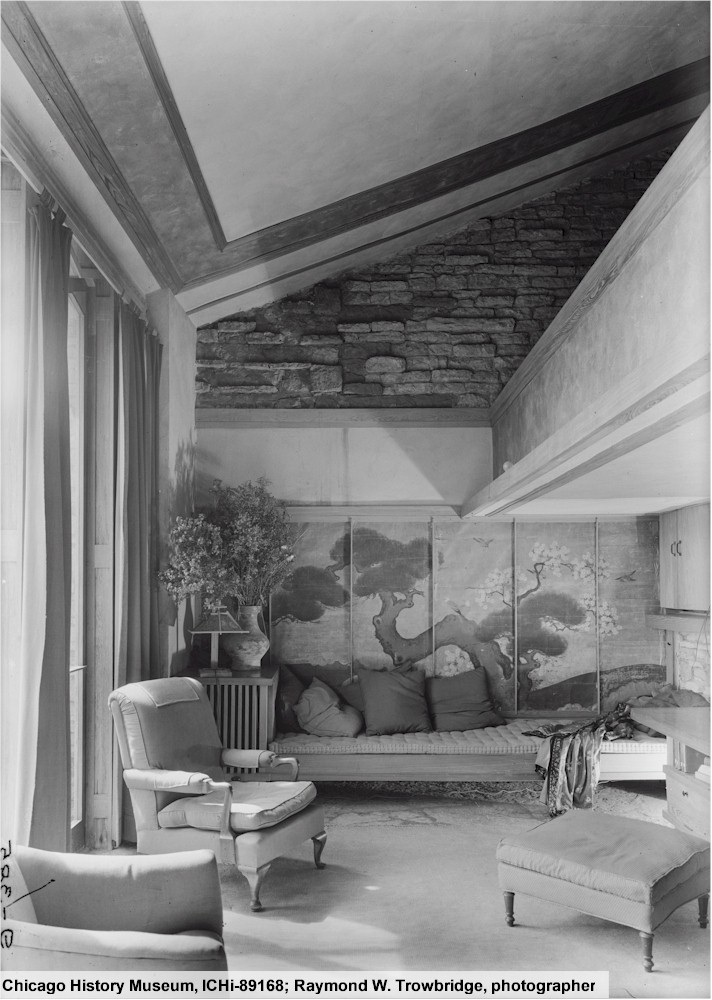
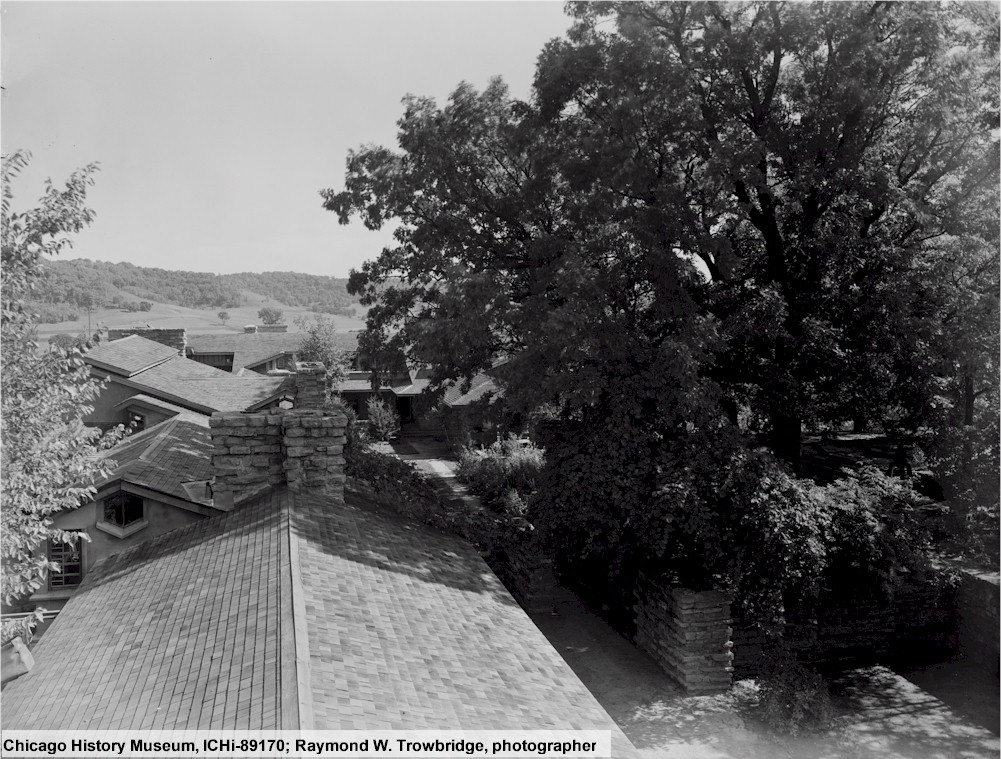
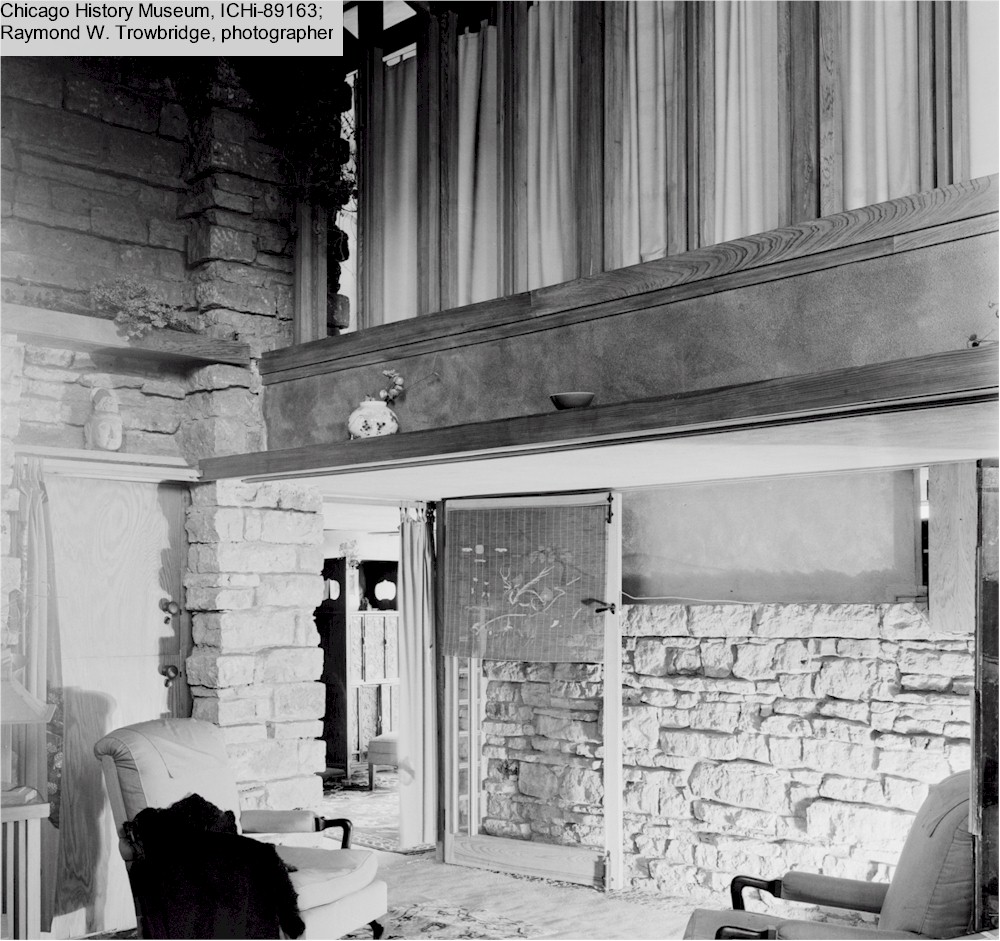
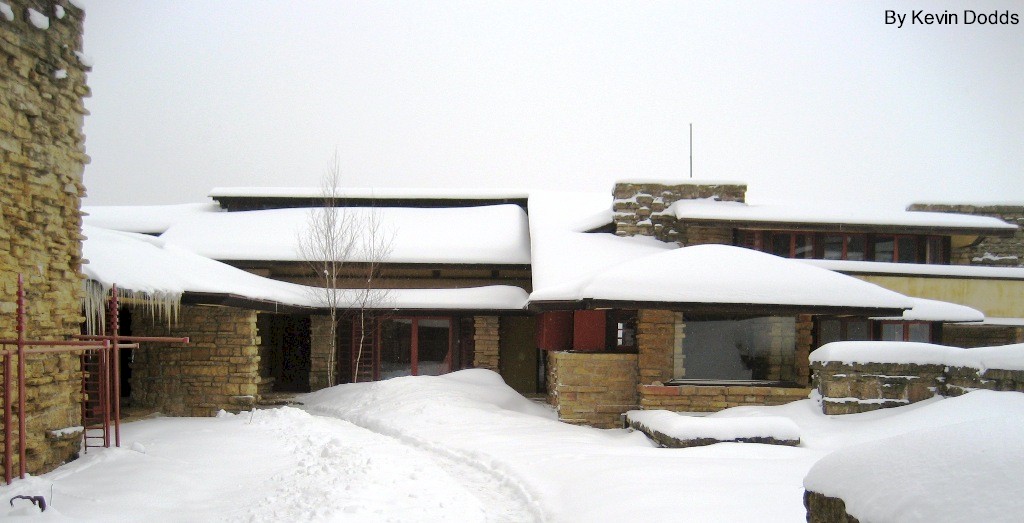

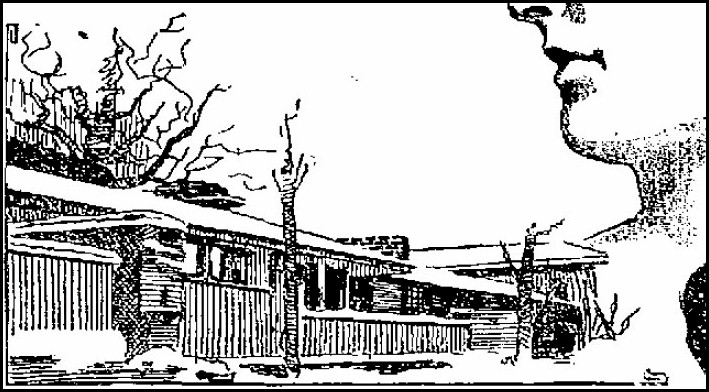
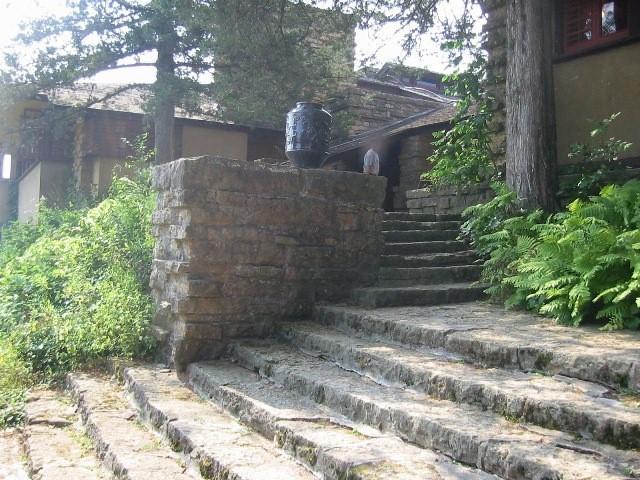 You walk up the steps at Taliesin to Wright’s studio at Taliesin (the north wall of the studio is to the right). The parapet from the Taliesin I photo ended at the stone that is to the left of the tree trunk (the tree trunk is to the left of the window that’s on the extreme right in the photograph) .
You walk up the steps at Taliesin to Wright’s studio at Taliesin (the north wall of the studio is to the right). The parapet from the Taliesin I photo ended at the stone that is to the left of the tree trunk (the tree trunk is to the left of the window that’s on the extreme right in the photograph) .